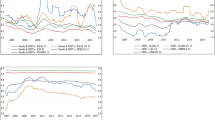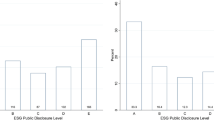Abstract
This paper studies the role of restructuring, as compared to the one of liquidation, in valuation of long-term debt contracts in a continuous-time model with costly information disclosure. In asset-pricing literature, Merton’s (J Finance 29:449–470, 1974) contingent-claim models have been long used for valuation of corporate securities and loans. However, since they basically assume sufficiently complete security structures in markets, the literature is not necessarily suitable for examining costly-information problems. On the other hand, in corporate-finance literature, it has been well known that agency costs (i.e., conflicts of interest among agents) distort corporate capital structure under costly-information problems. However, the effect of the distortion on valuation of securities and loans has not been explicitly studied either in theory or in practice. This paper bridges such a gap between the two literatures. This paper shows that, under a costly-information problem, corporate leverage ratios are higher when restructuring is expected to be accepted in default than otherwise. The risk of a jump to liquidation increases the default probability in short term, and decreases the probability of restructuring over time.
Similar content being viewed by others
References
Altman E. I. (1984) A further empirical investigation of the bankruptcy cost question. Journal of Finance 39: 1067–1089
Anderson R. W., Sundaresan S. (1996) Design and valuation of debt contracts. Review of Financial Studies 9: 37–68
Bensoussan A., Lions J.-L. (1982) Impulse Control and quasi-variational inequalities. Gautier-Villars, Bordas
Brekke K. A., Øksendal B. (1991) The high contact principle as a sufficiency condition for optimal stopping. In: Lund D., Øksendal B. (eds) Stochastic models and option values. Elsevier, North-Holland, pp 187–208
Broadie M., Chernov M., Sundaresan S. (2007) Optimal debt and equity values in the presence of chapter 7 and chapter 11. Journal of Finance 62: 1341–1377
Chemmanur T. J., Fulghieri P. (1994) Reputation, renegotiation, and the choice between bank loans and publicly traded debt. Review of Financial Studies 7: 475–506
Chen, N. (2003). Chapter 11, private workouts and corporate debt pricing under asymmetric information. mimeo.
Cvitanić J., Wan X., Zhang J. (2006) Optimal contracts in continuous-time models. Journal of Applied Mathematics and Stochastic Analysis 2006(95203): 1–27
Cvitanić J., Wan X., Zhang J. (2009) Continuous-time principal-agent problems with hidden action and lump-sum payment. Applied Mathematics and Optimization 59: 99–146
Cvitanić J., Zhang J. (2007) Optimal compensation with adverse selection and dynamic actions. Mathematics and Financial Economics 1: 21–55
DeMarzo P. M., Sannikov Y. (2006) Optimal security design and dynamic capital structure in a continuous-time agency model. Journal of Finance 61: 2681–2724
Diamond D. (1984) Financial intermediation and delegated monitoring. Review of Economic Studies 57: 393–414
Duffie D., Lando D. (2001) Term structure of credit spreads with incomplete accounting information. Econometrica 63: 633–664
Dye R. A. (2001) An evaluation of essays on disclosure and the disclosure literature in accounting. Journal of Accounting and Economics 32: 181–235
Epstein L., Peters M. (1999) A revelation principle for competing mechanisms. Journal of Economic Theory 88: 19–160
Fan H., Sundaresan S. M. (2000) Debt valuation, renegotiation, and optimal dividend policy. Review of Financial Studies 13: 1057–1099
Gertner R., Scharfstein D. (1991) A theory of workouts and the effects of reorganization law. Journal of Finance 46: 1189–1222
Gilson S. C. (1995) Investing in distressed situations: A market survey. Financial Analysts Journal 51: 8–27
Gilson S. C., John K., Lang L. H. P. (1990) Troubled debt restructurings: An empirical study of private reorganization of firms in default. Journal of Financial Economics 27: 315–353
Goldstein R., Ju N., Leland H. (2001) An EBIT-based model of dynamic capital structure. Journal of Business 74: 483–512
Harrison J. M. (1985) Brownian motion and stochastic flow system. John Wiley, New York
He, Z. (2008). A model of dynamic compensation and capital structure. mimeo.
Kimball M. S., Mankiw N. G. (1989) Precautionary saving and the timing of taxes. Journal of Political Economy 97: 863–879
Leland H. E. (1994) Corporate debt value, bond covenants, and optimal capital structure. Journal of Finance 49: 1213–1252
Leland H. E. (1998) Agency costs, risk management, and capital structure. Journal of Finance 53: 1213–1243
Leland H. E. (2004) Predictions of default probabilities in structural models of debt. Journal of Investment Management 2: 1–28
Mella-Barral P., Perraudin W. (1997) Strategic debt service. Journal of Finance 52: 531–556
Merton R. C. (1974) On the pricing of corporate debt: The risk structure of interest rates. Journal of Finance 29: 449–470
Nakamura, H. (2006). A dynamic theory of debt restructuring. Working paper, #CARF-F-072, University of Tokyo.
Nakamura, H. (2010). Continuous-time optimal contracts with costly information disclosure: Analysis of strategic default probability. mimeo. Credit risk analysis based on a continuous-time optimal security design. mimeo.
Øksendal B. (2003) Stochastic differential equations (6th ed.). Springer, Berlin
Øksendal B., Sulem A. (2005) Applied stochastic control of jump diffusions. Springer, Berlin
Strebulaev I. A. (2007) Do tests of capital structure theory mean what they say?. Journal of Finance 62: 1747–1787
Townsend R. (1979) Optimal contracts and competitive markets with costly state verification. Journal of Economic Theory 21: 265–293
Wang C. (2005) Dynamic costly state verification. Economic Theory 25: 887–916
Warner, J. B. (1977). Bankruptcy costs: Some evidence. Journal of Finance. In Papers and proceedings of the thirty-fifth annual meeting of the American finance association (Vol. 32, pp. 337–347). Atlantic City, September 16–18.
Yu F. (2005) Accounting transparency and the term structure of credit spreads. Journal of Financial Economics 75: 53–84
Author information
Authors and Affiliations
Corresponding author
Additional information
This paper is an extension of my Ph.D thesis. Previously, it was entitled “A Continuous-Time Analysis of Optimal Contracts under Costly State Verification: Theory and Applications.” I would like to thank Ed Green and Akihiko Takahashi for his constant encouragement and advice throughout the preparation of this work. I would also like to thank Lars Peter Hansen, Milton Harris, and Shigeo Kusuoka for their help at various stages. I am also thankful to the anonymous referee and Joshua Aizenman, Alessandro Barbarino, Javier Birchenall, Toni Braun, Marco Cagetti, Sean Campbell, Dan Friedman, Ricard Gil, Erik Heitfield, Tokuo Iwaisako, Michihiro Kandori, Jinill Kim, Yong Jin Kim, Ken Kletzer, Hyeng Keun Koo, Andy Levin, Jeffrey Marquardt, Travis Nesmith, Kazuhiko Ohashi, Shige Peng, Matthew Pritsker, Akihiko Matsui, Makoto Saito, Jun Sekine, Jaeyoung Sung, Carl Walsh, Egon Zakrajšek, and all seminar participants at 10th Econometric Society World Congress (Shanghai), 10th SAET Conference on Current Trends in Economics (Singapore), the 2007 Annual meetings of the Society for Economic Dynamics (Prague), the 2007 North American Summer Meeting of the Econometric Society (Duke University), the 2006 Nippon Finance Association annual meetings, Ajou University, Federal Reserve Board of Governors, Hitotsubashi University, Kyoto University, University of California, Santa Cruz, University of Tokyo, and Tokyo Finance Workshop for their comments. I am thankful to Roger Smith for editing assistance.
Rights and permissions
About this article
Cite this article
Nakamura, H. A Continuous-Time Analysis of Optimal Restructuring of Contracts with Costly Information Disclosure. Asia-Pac Financ Markets 19, 119–147 (2012). https://doi.org/10.1007/s10690-011-9144-6
Published:
Issue Date:
DOI: https://doi.org/10.1007/s10690-011-9144-6




